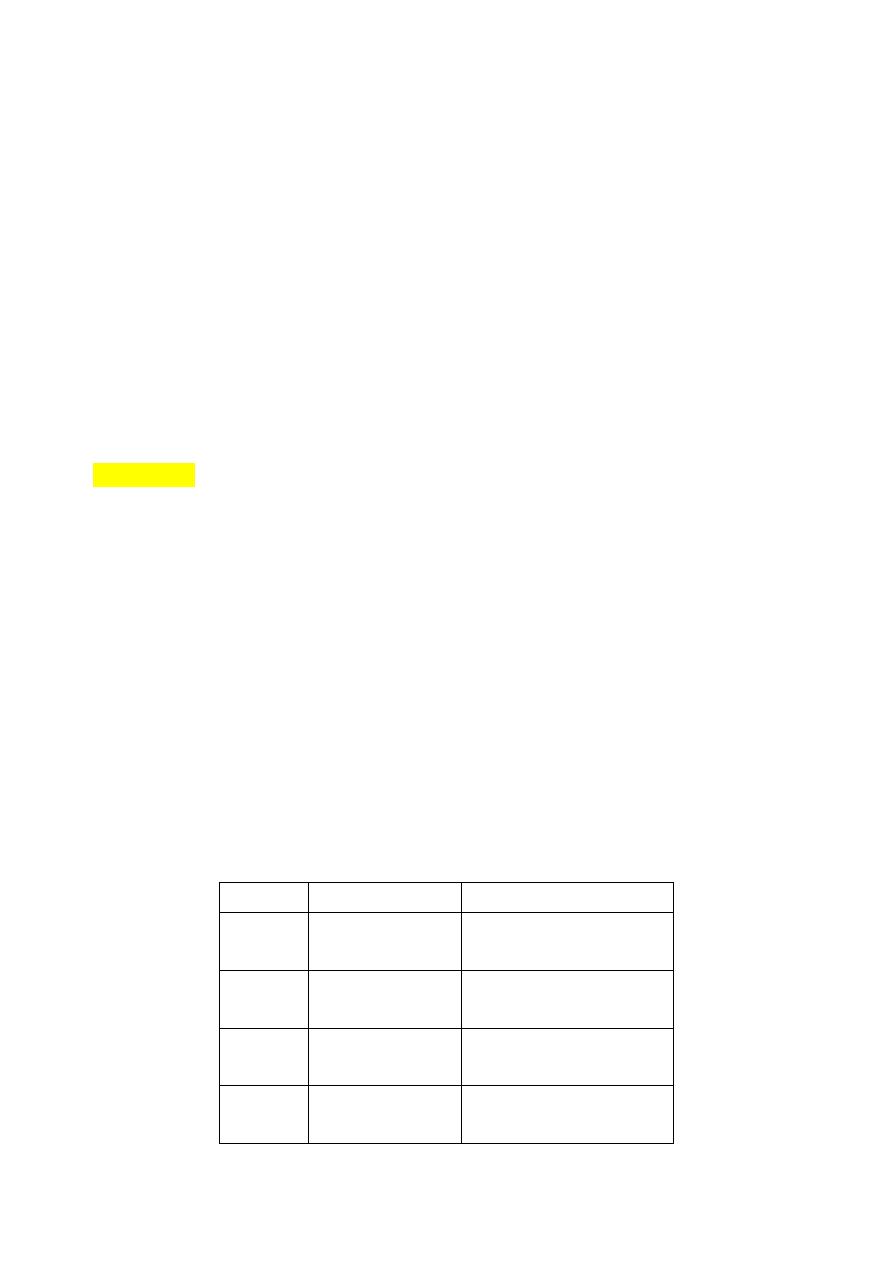
Dr. Rihab Faisal
Diabetes Mellitus
Lecture 2
Management of Hyperglycemia without Acidosis and Continuous Phase
Insulin
*Dose
: Starting dose of insulin is depend on the clinical presentation, weight, and
pubertal stage. Post-DKA or hyperglycemia without DKA: U/kg/day,
subcutaneous as follow: ()لالطالع
No DKA
Post-DKA
Prepubertal
0.25-0.5
0.75-1
Pubertal
0.5-0.75
1-1.2
Post-pubertal 0.25-0.5
0.8-1
If there is poor glycemic control with an insulin requirement > 1.5 U/kg/day,
consider non-adherence with therapy.
*Types:There are 3 types of insulin:
1. Animal insulin (from animal pancreas): no longer available as it is
immunogenic.
2. Human insulin (rDNA insulin, structurally identical to human insulin): as lente
and soluble insulin. It is less likely allergic than animal insulin. All human
insulins form hexamers, which must dissociate into monomers subcutaneously
before being absorbed into circulation.
Delayed absorption and prolonged action
of human insulins contribute to problems of hyper and hypoglycemia,
necessitating feeding the insulin with snacks and limiting the overall degree of
blood glucose control.
3. Insulin analogs (a modification of human insulin): Modification of site of amino
acids in insulin changed the pharmacokinetic properties of insulin, primarily
affecting the absorption of drug from the subcutaneous tissue (rapid absorption
for rapid analogs aspart and lispro and prolonged absorption for long acting
analogs glargine and detemir).
*Regimens: It includes:

• Conventional regimen; CR.
• Basal-bolus regimen; BBR:
▪ Multiple Daily Injection (MDI).
▪ Continuous Subcutaneous Insulin Infusion (CSII) by insulin pump.
CR
Two-third of total daily dose in the morning before breakfast and one-third in the
evening before dinner, two-third NPH and one-third regular or rapid acting analog.
It produces the least physiologic profile with substantial risk of hypoglycemia
before lunch and during the early night combined with breakthrough
hyperglycemia before supper and breakfast so requiring timing of injections,
specific mealtimes, specific meal amounts, and snacks (rigid regimen), but has the
advantage of twice-daily injection.
MDI
It Provides more physiologic insulin effects with more flexibility (no fixed
mealtime, no fixed meal amount, extra snack can be added, meal may even be
missed), and less likelihood of DKA if many bolus doses are missed, but has the
disadvantage of at least four injection per day, including at school and education is
complex as the patient or family must count carbohydrate in each meal consumed.
It consist of:
Basal insulin dose (30-50 % of total insulin dose) that provide fasting
insulin needs which achieved by long acting analog once usually at bedtime
(glargine) or twice (detemir) daily, and
Bolus insulin doses (50-70 % of total insulin dose) that covers food
requirements and correct hyperglycemia and achieved by rapid acting analog
(aspart and lispro) before meals and snacks (anything containing ≥ 10g
carbohydrate).
CSII
It use rapid acting analogues for both, basal and bolus infusion. Dosages
calculation is the same as MDI regimen.
It provides Less number of injections
(infusion set must be changed every 2-3 days), but the disadvantage is that DKA
will develop within hours if there is a problem in the infusion set, as there is no
long acting insulin.

For determining the best insulin regimen for an individual the following factors
should put in our minds:
• The availability of an adult parent/guardian to supervise insulin
administration.
• The ability to count carbohydrates and monitor blood sugar (BS) levels, and
• The willingness to wear a pump or take four or more injections of insulin
daily.
*Injection sites: They include arms (lateral aspect), abdomen, thighs (front/lateral
part), and buttocks (upper outer quadrant). subcutaneous injection in arm and
abdomen in young children might result in intramuscular injection as they have
less subcutaneous tissue in these sites (so should be avoided).
Monitoring
*Blood glucose monitoring: The safety and success of any insulin regimen
depend on frequent monitoring of blood glucose levels, which achieved by Home
(self) monitoring and HbA1c.
Home monitoring: the targets are as close to metabolic normalcy and avoiding
hyper or hypoglycemia. It is either by Glucose meter (accurate to within about
5%-10% of lab venous measurements) in which at least four tests per day
(premeals and at bedtime), or Continuous glucose monitoring (CGM) which is
available now.
Targets blood sugar according to the age:()لالطالع
Age (year) Premeal
mg/dl
Bedtime/overnight mg/dl
<5
100-200
110-200
5-11
80-150
100-180
12-15
80-130
90-150
16-18
70-120
90-150

HbA1c: It provides the gold standard by which to judge the adequacy of the
insulin regimen. It represents the fraction of hemoglobin to which glucose
has been non-enzymatically attached in the blood stream, and continue
irreversibly throughout the RBC life span of approximately 120 days. So,
HbA1c should be checked every 3 months. In children, based on International
Society of Pediatric and Adolescent Diabetes (ISPAD) recommendations, our
general goal is to keep all patients under 7.5% regardless of the patients age.
*Monitoring for complications and associated autoimmune diseases
which
include
microvascular
(retinopathy
and
nephropathy),
macrovascular
complications, neuropathy, cataract, and thyroid and celiac disease (as
patients
with T1DM are at increased risk for autoimmune diseases).
Other quite rarely noted complications now (as improvement in overall metabolic
control) in diabetic children include:
• Mauriac syndrome: dwarfism associated with a glycogen-laden enlarged
liver.
• Osteopenia, and
• Syndrome of limited joint mobility associated with tight, waxy skin; growth
impairment; and maturational delay.
Nutrition
Appropriate energy intake is required to meet the needs for energy expenditure,
growth, and pubertal development , and it not differ from that of non-diabetic
children.
Heart-healthy diets are encouraged, which consist of 50% carbohydrate, 20%
protein, and 30% fat (< 10% saturated fat). Approximately 70% of the
carbohydrate content should be derived from complex carbohydrates such as
starch and intake of sucrose and highly refined sugars should be limited. Dietary
fats derived from animal sources (saturated) are reduced and replaced by
polyunsaturated fats from vegetable sources. Substituting margarine for butter,
vegetable oil for animal oils in cooking, and lean cuts of meat, poultry, and fish for

fatty meats is advisable. The intake of cholesterol is also reduced by these
measures and by limiting the number of egg yolks consumed. These simple
measures reduce serum low-density lipoprotein cholesterol, a predisposing factor
to atherosclerotic disease.
Diet with high fiber content (grain, legumes, fruits and vegetables) are useful in
improving glucose control.
As vegetables and fruits are a natural source of
antioxidants, as with other children, at least five portions are recommended in
diabetics to provide some protection against long-term cardiovascular disease.
Regarding sweeteners, there is no available data to support an association of
moderate amount of saccharin ingestion with bladder cancer in children.
Aspartame is used in variety of products and it contraindicated in
phenylketonuria, and Fructose in both diabetic and healthy populations increase
LDL-cholesterol and may stimulate energy intake and promote weight gain. So
adding large amount of fructose to the diet is undesirable. These concern should
not extend to naturally occurring fructose in fruits and vegetables as they provide
only modest amount of fructose.
Cakes and even candies are permissible on special occasions as long as insulin
dose is adjusted to accommodate this increased caloric intake to not foster
rebellion and stealth in obtaining desired food.
Meal plans should fit the child and family's food preference and provide satiety
necessary for realistic adherence.
In a conventional regimen, constancy in timing and amount of carbohydrate meal
is important to avoid hyper and hypoglycemia. Thus, the total daily caloric intake
is divided to provide 20% at breakfast, 20% at lunch, 30% at dinner, leaving 10%
for each of the midmorning, midafternoon, and evening snack (this strict divisions
are not required in basal-bolus regimen). While in basal bolus regimen, near total
flexibility in timing and amount of meals is possible provided that patients and
families understand insulin dose calculation.
Exercise
Physical fitness and regular exercise are encouraged in all children with DMT1 as
it improves glucoregulation by increasing insulin receptor number and no form of
exercise is forbidden. However, it requires specific attention (blood glucose
monitoring to assess the effect of exercise and then to determine an effective
regimen for the individual child). Complications of exercise are:

•
Hypoglycemia: It is a common complication and occurs during or after low-
to-moderate-intensity exercise due to increased insulin absorption from its
injection site. It may occur hours post-exercise reflecting depleted glycogen stores.
•
Hyperglycemia: It occurs during or immediately after high-intensity exercise
as a result of exercise-induced increase in the counterregulatory hormones, and so
in patient with poor metabolic control vigorous exercise should not be performed
as it may precipitate DKA.
HYPOGLYCEMIA
The ADA defines biochemical Hypoglycemia in diabetic patients (with or without
symptoms) as any BS <70 mg/dl.
Hypoglycemia is the major limitation to tight
control of glucose levels and it occurs as a result of mismatching between insulin,
food, and exercise, which may be due:
1. Taking too much insulin.
2. Missing or delaying a meal.
3. Vigorous exercise (may occur immediately or delayed by several
hours).
4. Alcoholism (especially in excess).
Decreased BS values and decrease insulin requirement well after the time
expected to span the honeymoon period might indicate the development of the
followings:
1. Addison's disease.
2. Hypothyroidism.
3. Celiac disease.
4. Renal failure.
Hypoglycemia should be treated with oral glucose (5-10 g) as juice or a sugar-
containing beverage or candy, and the blood glucose checked 15-20 min later and
the administration of glucagon when the child cannot take glucose orally.
DAWN AND SOMOGYI PHENOMINA

There are several reasons that blood glucose levels increase in the early morning
hours before breakfast. The most common dawn phenomenon which occurs as a
result of combination of waning overnight insulin and early morning rise in
counter-regulatory hormones and treated by increasing the evening dose of lente
or long acting analog. Rarely, high morning glucose is caused by the Somogyi
phenomenon, a theoretical rebound from late-night or early-morning
hypoglycemia, thought to be from an exaggerated counterregulatory response and
so treated by decreasing the evening dose. To distinguish between the two
conditions ,we should measure the blood sugar at 3 am- 4 am and at 7 am-9 am. If
blood sugar >80 mg/dl in the first sample and markedly high in the last one ,it
means dawn phenomenon. If blood sugar <60mg/dl in the first sample followed by
hyperglycemia at 7 am , this mean Somogyi phenomenon.
